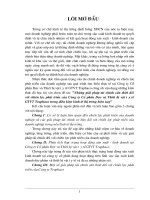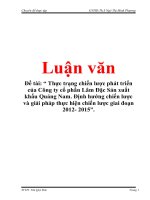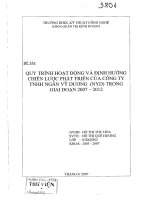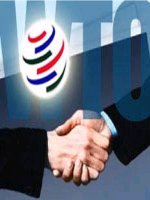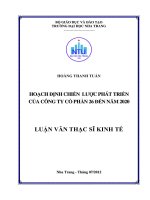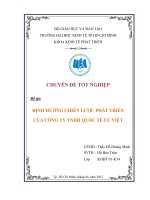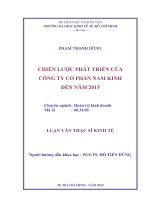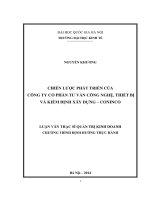ĐỊNH HƯỚNG CHIẾN lược PHÁT TRIỂN của CÔNG TY cổ PHẦN NAM dược đến năm 2020 e
Bạn đang xem bản rút gọn của tài liệu. Xem và tải ngay bản đầy đủ của tài liệu tại đây (1.07 MB, 99 trang )
INTERNATIONAL EXECUTIVE
MASTER OF BUSINESS ADMINISTRATION PROGRAM
THESIS
ORIENTAL DEVELOPMENT STRATEGY OF NAM
DUOC JOINT STOCK COMPANY TO 2018
CONTENT
INTRODUCTION
CHAPTER 1: THEORETICAL BASIS FOR DEVELOPING COMPANY’S
BUSINESS STRATEGIES
1.1.Role of a strategy and a business strategy
1.1.1.Strategy and strategic levels
1.1.2.Business strategy and its orientations
1.1.3.Role of business strategy for a company
1.2.Model for developing a company’s business strategy
1.2.1.Analysis and development process of a comprehensive strategy
1.2.2.External environment analysis
1.2.3.Internal Factors evaluation
1.3.Business strategy selection model
1.3.1.Analysis model of Threats - Opportunities - Weaknesses - Strengths Matrix
(TOWS) .
1.3.2.Strategic Position and Action Evaluation Matrix (SPACE)
1.3.3.Quantitative Strategic Planning Matrix (QSPM)
CHAPTER 2: ANALYSIS OF ENVIRONMENT AND BUSINESS
SITUATION OF NAM DUOC JOINT STOCK COMPANY24
2.1.Introduction of Nam Duoc joint stock company
2.1.1.Overview of establishment and development history24
2.1.2.Structure of Nam Duoc joint stock company27
2.1.3.Functionally, the basic task of the management department27
2.1.4.Status of activities Nam Duoc joint stock company period 2010 - 201229
2.2.Analysis of the macro environment and industry environment of the
company to identify threatss and opportunities32
2.2.1.Analysis of the macro environment (PESTEL)32
2.2.2.Analysis of the industry environment39
2.2.3.Industry Analysis - external factor evaluating matrix50
2.3.Analysis to identify the strengths and weaknesses of Nam Duoc51
1
2.3.1.Marketing Capability51
2.3.2.Operation Capacity54
2.3.3.Financial capacity55
2.3.4.Research and development capacity58
2.3.5.The capacity of information systems60
2.3.6.The capacity of human resources60
2.3.7.Analysis of company operations: Matrix of Internal factors evaluating61
2.4.Summary of analysis of opportunities, threatss, strengths, weaknesses63
CHAPTER III. CONCLUSIONS AND SOLUTIONS66
3.1.1.Model analysis of threats, opportunities, weaknesses, strengths (TOWS) ..66
3.1.2.SPACE model of strategic options for the operations of Nam Duoc68
3.2.Apply Quantitative Strategic Planning Matrix (QSPM) for strategy
selection70
3.3.Proposed corporate strategy73
3.3.1.The objective of the main targets73
3.3.2.Strategy for Market and Product
3.3.3.Propose solutions for implementation
3.3.4.Recommendations for implementation and strategic management
CONCLUSION
REFERENCES
Appendix 1: Model 5 competitive force of Michael E. Porter
Appendix 2: Example of strategic position and action evaluation matrix
(SPACE)
Appendix 3: Structure of Nam Duoc J.S.C
Appendix 4: GDP growth in 2010-2012 & forecast 2013-2015
Appendix 5: Comparison of Vietnamese economic growth with the past and in
comparison with other countries in the area
Appendix 6: Information of population concerning to health sector in Vietnam
Appendix 7: Value and growth of the pharmaceutical industry market
segments in Vietnam
2
Appendix 8: Summary of implementation and investment in market research
of Nam Duoc in 2010-2012
Appendix 9: Images of the factory and line production of Nam Duoc Joint
Stock Company
Appendix 10: Personnel structure and staffing levels of Nam Duoc at 31th
Junne, 2013
Appendix 11: Movements in key personnel in the first 6 months of 2013
Appendix 12: The question of Drug store and agent research in July, 2013
Appendix 13: The survey questionnaire, assessing the current state of strategy,
management system for the chiefs of functional departments
3
LIST OF ABBREVIATIONS
-------------------List of Vietnamese Abbreviations
ECO: ECO Pharmaceutical Joint Stock Company
FTA: Market-Oriented research company
GS.: Professor
GVHD: Course Instructor
Sao Thai Duong: Sao Thai Duong Pharmaceutical Joint Stock Company
OPC: OPC Pharmaceutical Joint Stock Company
TS.: Dr.
Nam Duoc: Nam Duoc Joint Stock Company
Traphaco: Traphaco Joint Stock Company
------------------List of English Abbreviations
1. BMI:
Business Monitor International
2. EFE:
External Factor Evaluation Matrix
3. ETC:
Ethical
4. GDP:
Gross Domestic Products
5. GLP:
Good Laboratory Practice
6. GMP:
Good Manufacturing Practice
7. GNP:
Gross National Product
8. GSP:
Good Storage Practice
9. HACCP: Hazard Analysis and Critical Control Points
10. IFE:
Internal Factor Evaluation Matrix
11. IMS:
Intergraded Management System
12. ISO 9000:2008: International Organization of Standard
13. KPI:
Key Performance Indicator
14. MBA:
Master of business administration
15. OTC:
Over-The-Counter
16. R&D: Research and Development
17. SA 8000: Social Accountability
18. TRIPS: Agreement on Trade-Related Aspects of Intellectual Property Rights
19. WHO: World health organization
1.
2.
3.
4.
5.
6.
7.
8.
9.
4
LIST OF TABLES
Table 1.1 Definitions of particular strategies
Table 1.2 Framework for strategy analysis
Table 1.3 Competitive Image Matrix.
Table 1.4 Example of EFE Matrix
Table 1.5 Example of Internal Factors Evaluation Matrix
Table 1.6 Tows Matrix
Table 1.7 QSPM Matrix
Table 2.1 Subsidiaries, associated companies of Nam Duoc
Table 2.2 Balance Sheet of Nam Duoc in 2010-2012
Table 2.3 Business Results of Nam Duoc 2010-2012
Table 2.4 Business Results of Nam Duoc first 6 months of 2013 compared to
the same period of 2012
Table 2.5 The size and growth of Nam Duoc market 2009-2017
Table 2.6 Matrix of image competition of Nam Duoc compared to direct
competitors48
Table 2.7 Matrix of external factors evaluating(EFE)
Table 2.8 Revenue and market share of the main herbal brands in the market of
sinusitis
Table 2.9 Number of personnel in distribution system of Nam Duoc from 2010
– June 2013
Table 2:10 Profitability indicators of Nam Duoc in 2010-2012
Table 2.11 Indicator assessment asset management capability in 2010-2012
Table 2.12 Indicators of the solvency in 2010-2012
Table 2.13 Investments and research & development results
Table 2:14. Matrix of Internal factors evaluating (IFE)
Table 3.1 Tows Matrix
Table 3.2 Model selection strategies SPACE in Nam Duoc
Table 3.3 QSPM for Nam Duoc’s strategy selection
Table 3.4 Oriented targets of Nam Duoc by 2018
5
Table 3.5 Proposed strategic product groups
LIST OF FIGURES
Figure 2.1 Structure of Vietnam's population
Figure 2.2 ROE of the pharmaceutical industry in Vietnam
Figure 2.3 The sequence of the pharmaceutical companies are high appreciated
for the customer care service
6
INTRODUCTION
Purposes and reasons for the thesis topic
Medicinal product is a special commodity with many specific characteristics.
Thanks to current trend of integration, pharmaceutical industry in Vietnam in
general and herbal medicine in particular is developing quickly. It is estimated that
the rate of the pharmaceutical industry’s development in Vietnam to grow from 15%
to 20% annually, in which herbal medicine and functional foods grew by 25%. That
is the reason why in the past 5 years, the number of firms participating in this
market is growing rapidly. Besides, the trend of imported herbal products also
increased significantly. From June 2012 to the present, due to signs of difficulties in
economy and adjustments in the government policies, the growth rate of this sector
seems to slow down and compete fiercely.
Nam Duoc has been established for 10 years. Since its establishment, the
company has developed in-depth orientation of herbal products and natural
medicines. Following plant construction phase (2004 - 2006), the company
sometimes struggled due to spreading investment and capital crisis (2006-2009).
But from 2009 to now, the company has grown at a very rapid pace. Nam Duoc is
considered one of the most promising companies in the pharmaceutical industry,
attracting great interest from investors. However, from June 2012 to June 2013 there
are signs of slowdown and potential risks in Nam Duoc’s growth rate. The company
began experiencing some confusion in strategy, a number of products started
showing signs of revenue decline and key personnel began leaving. Many projects
were considered but not defined as strategic priorities, causing the Board to be
confused in project selections.
As an MBA student and working in a management position, I chose my
thesis with following research topic: “Oriental Development Strategy of Nam Duoc
joint stock company to 2018.”
Research Goals:
7
a. Systemize theories related to the research topic.
b. Analyze, evaluate and realize issues related to the research topic.
c. Propose strategies and solutions for strategy implementation of Nam
Duoc joint stock company from now to 2018.
Research Scope:
Strategic management is the process of identifying strategic objectives of the
organization, developing policies and plans to achieve the set objectives and
allocate the organization’s resources for implementation. This is a very broad field
in a company’s operation and needs to be studied on large scale and for a long time.
Due to limited researching time, however, the thesis only focuses on analyzing and
evaluating external factors and internal resources, from which I propose a
comprehensive strategy for Nam Duoc joint stock company from present to 2018.
Research Methodology:
The author used research methods as analysis, synthesis, statistical
comparisons to perform his task. The author collected following external
information:
General information on economy, politic, society, culture and law:
annual reports made by World Bank, global economic organizations
and Vietnam Government.
Basic information of the industry, including: size, trend and cycles of
development of the sector and sub-sectors, consumption information
related to the industry, information found from reports made by World
Health Organization (WHO) and Bussiness Monitor International
(BMI).
The author studied information on competitive capacity including
brand position, compared competitive factors by a direct survey of the
distribution channel. The author conducted a survey of 200 product
8
distribution agencies, in which there were 50 samples in Hanoi, 50
samples in Ho Chi Minh City and 100 samples in other 10 major cities
nation-wide.
The author undertook an internal study by means of in-depth
interviews and group discussions with all Chiefs and Deputies of
functional departments of companies.
Thesis significance
For the past 10 years, the development process of Vietnam pharmaceutics
industry has been stable and promising and the competition has not yet been fierce.
From the beginning of 2012 the competition has become fiercer and more complex.
Local pharmaceutics companies are facing many challenges, especially from
international competitors. However, thanks to good development trends and
potentiality of Vietnam herbal industry, there are great opportunities for companies
like Nam Duoc. With the above research objectives, the implementation of this
project aimed at proposing directions and strategic solutions for 5 years (20132018) for Nam Duoc Joint Stock Company.
Thesis Structure
In addition to table of contents, thanks, list of tables, list of diagrams,
references and appendices, the thesis structure includes:
Introduction: Research purpose and methodology.
Chapter 1: Theoretical basis for building business strategies of a company.
Chapter 2: Analyze environment and business status of Nam Duoc Joint
Stock Company.
Chapter 3: Conclusions and Solutions
9
CHAPTER 1: THEORETICAL BASIS FOR DEVELOPING COMPANY’S
BUSINESS STRATEGIES
1.1.
Role of a strategy and a business strategy
1.1.1. Strategy and strategic levels
Concept of a strategy and strategic management is mentioned in different
materials and under different perspectives. In this thesis the author only mentions
popular and easily accessible concepts.
1.1.1.1.
Concept of a strategy
According to Michael Porter, a strategy is to create a unique and valuable
position, including differences and breakthrough choices to fully use of all
resources, from which to create advantages for the company [3].
According to William J. Glueck, a strategy is a consistent, comprehensive
and combined plan which is designed to ensure that all basic objectives of a
company shall be implemented [2].
1.1.1.2.
Concept of strategic management
According to Alfred Chandler, strategic management is the process of
determining basic and long-term goals of a company, selecting methods or course of
action and allocating necessary resources to implement those objectives [2].
According to Fred David, strategic management might be defined as an art to
conduct and evaluate related decisions, allowing a company to achieve its set
objectives [1].
1.1.1.3.
Strategic levels
Currently companies are using three most common strategic levels as
followed [1]:
Corporate strategy
10
A corporate strategy is a long-term strategy related to its mission,
comprehensive objectives and scale to meet expectations and will of the company’s
owner and senior managers. The corporate strategy is a long-term and
comprehensive vision controlling other kinds of strategies, namely business or
functional ones.
Business strategy
A business strategy is about how a company might successfully compete in a
particular market, about strategic decisions on product selection to meet customer
needs, find competitive advantages against competitors and creating new
opportunities.
Functional strategy
A functional strategy is about how departments and units of a company shall
organize, operate and evaluate to implement their business strategy and strategy at
company level. The functional strategy aims at resources and implementation tactics
including: strategies for marketing, finance, R&D, manufacturing and human
resources.
1.1.2. Business strategy and its orientations
In reality particular business strategies might be classified into 14 types as
shown in Table 1.1 [1].
Table 1.1 Definitions of particular strategies
No.
1
2
3
Strategy
Definition
Forward
Increase ownership or control over distributors and
integration
retailers.
Backward
Search for ownership or control of the company's
integration
suppliers.
Horizontal
Find out ownership or control of over competitors.
11
integration
Market penetration Search for increasing market shares for available
4
products and services in existing markets by greater
marketing efforts.
5
6
7
8
9
10
11
Market
Bring available products and services into new markets.
development
Product
Increase sales by improving or modifying products and
development
services.
Concentric
Add new and related products or services.
diversification
Conglomerate
Add new products or services without any connection.
diversification
Horizontal
Add products or services connected to existing clients.
diversification
Joint venture
Two or more sponsoring firms merging into one
independent company for purposes of collaboration.
Retrenchment
Turnaround by cutting costs and assets to save
declining turnover and profits.
12
Divestiture
Sell a branch or a part of the company.
13
Liquidation
Sell all assets partially, with visible values.
14
Synthesis
Pursuing two or more strategies at the same time.
1.1.3. Role of business strategy for a company
Strategic management process helps a company to clearly see its purposes
and direction. It helps administrators to consider and determine their directions and
time to reach a certain position. Awareness of desired results and future objectives
helps managers and their employees to master what to do to achieve success. This
12
will encourage the above subjects to gain short-term achievements, in order to better
improve the company’s long-term interests.
The organization faces a changeable environment. Quick changes often lead
to opportunities and unexpected risks. Managers might focus on future
opportunities and risks by using strategic management, although the planning
process does not exclude anticipation of managers for future environment
conditions. Meanwhile, the strategic management process forces managers to
analyze and predict environmental conditions in near and far future. This helps them
to clearly see future environment and better seize opportunities, take advantage of
opportunities and reduce risks related to environmental conditions.
Most research shows that companies that use strategic management achieve
better results than companies that do not. Strategic management also helps
enterprises to avoid serious problems and increase their ability to take advantage of
environmental opportunities.
1.2.
Model for developing a company’s business strategy
1.2.1. Analysis and development process of a comprehensive strategy [1]
Strategy analysis and selection process aims at identifying optional activities
as a base for the company to fulfill its responsibility and goals. The company’s
existing strategies, objectives and missions combined with internal and external
controlling information shall be a foundation to establish and evaluate feasible
strategies. There are 3 stages to form a strategy which might be integrated into a
decision-making process as shown in Table 1.2:
Table 1.2 Framework for strategy analysis
Stage 1: Inputs
Matrix of external
Matrix of competitive
Matrix of internal factors
factors evaluation (EFE)
images
evaluation (IFE)
13
Stage 2: Combination
TOWS matrix
SPACE matrix
Stage 3: Decision-making
Quantitative strategic planning matrix (QSPM)
1.2.2. External environment analysis
1.2.2.1.
Macro-environment analysis (PESTEL) [1], [2], [4]
Macro environment includes the factors which have comprehensive impacts
on the company and its operation. Each factor alone or in associated with other
factors influence the company. Analysis of external environment helps the company
to answer the question: what it is facing now?
1) Economic factors
Economic factors often impact in a direct and dynamic manner. Evolution of
the economic environment always contains opportunities and threats to enterprises
and poses potential impacts to their strategies. Basic economic factors are as
followed:
Trend of Gross Domestic Products (GDP) and Gross National Products
(GNP): Includes data on GDP and GNP annual growth, showing economic
growth and increase of income per capita, from which helps us to predict
market capacity and market share of each company.
Interest rate and interest rate trends in the economy affect trends of
investment, savings and consumption, causing effects on operation of
enteprises.
Trend of exchange rate: exchange rates change business conditions in general,
create opportunities and threats for companies.
14
Inflation: high or low inflation rate affects investment in the economy. Both
hyperinflation and deflation put negative effects on the economy.
2) Political factors
Political environment includes a system of opinions and government’s
policies, trends of government’s politics and diplomatic and political changes in the
country, region and in the world. Changes of political environment shall create
opportunities and risks for enterprises. The state’s policies also affect these
companies, leading to profits or challenges for them, including policies on
commerce,
sector
development,
economic
development,
tax,
competitive
adjustment and consumer protection.
3) Socio-cultural factors
Socio-cultural factors have slow but deep and broad impacts on enterprises.
Population factor plays an important role during the process of strategy
development. It directly impacts on changes of socio-economic environment.
Information on population provides managers with important data for strategy
planning. Following points must be considered when studying this issue:
-
Population size, age structure
-
Geographical distribution
-
Diversity of the workforce
-
Allocation of income
-
Changes in the priorities related to features of products and services
-
Opinions on morality, aesthetics, lifestyle and career
-
Changes in views on living and living standards
-
Structure and trends of population change: age, gender, ethnicity,
occupation, religion, income distribution.
-
Trend of population movement among regions.
15
4) Technological factors
There are few industries and businesses that do not depend on modern
technology. There will be much technological advancement to come, creating
opportunities and risks for all sectors. Following points must be considered when
studying this issue:
-
Costs for research and development from state budget.
-
Costs for research and development fromthe industry.
-
Focus of technological efforts
-
Protection of patents.
-
Technology transfer
-
Automation
5) Environmental factors
Environment includes: geographical location, climate, natural scenery, sea
ports and resources. Natural conditions are important inputs of many economic
sectors and they might become strengths of a company. Therefore it is necessary to
focus on followings when developing a business strategy:
-
Types of resources
-
Problems of environmental pollution.
-
Shortage of energy.
-
Waste of natural resources.
6) Legal factors
These factors influence all sectors of business in a territory. Legal factors
may threaten existence and development of any sector. When trading on an
administrative unit, the enterprises are obliged to follow all the regulations of that
16
region. For pharmaceutical industry, following laws are the most important ones:
Laws on Investment, enterprises, pharmacy, labor, anti-monopoly, anti-dumping.
1.2.2.2 Industry analysis (Porter Five Forces) [3],[4]
1) Industry analysis
Industry environment is a part of macro-environment and directly impacts on
enterprises. An enterprise should not mechanically apply experiences of other
companies and they must study in conditions corresponding to their actual
situations. It is necessary to carefully analyze industry factors to develop a
successful strategy. Understanding of these factors helps enterprises realize their
strengths and weaknesses. It involves opportunities and risks facing these
enterprises. Industry environment include factors of: competitors, customers,
suppliers, potential competitors, substitute products. See Appendix 1 for Five Forces
of Porter.
a) Competitors
Competitors are companies who share customers with a company. Study of
competitors helps a company to identify extent and nature of their competition,
taking appropriate measures to maintain its position and increase pressure on
competitors. Followings are key contents when studying competitors:
-
Future goals of competitors.
-
Current strategies of competitors.
-
Impacts on competition in the industry.
-
Strengths and weaknesses of competitors.
-
Ability to shift and redirect strategies of competitors.
-
Results of current business of competitors.
b) Customers
17
Customers are people who consume and use products of a company. In order
to survive, companies needs to attract more customers and customer loyalty is a
business advantage.
To get it, companies must increasingly satisfy needs and desires of
customers. Customer research is very important to help companies get more closely
with customers. Points to be considered in customer research:
-
Why do customers buy or not buy products?
-
What demands of customers need to be considered?
-
What are key differences between different groups of customers?
-
How do customers buy products? When and how many?
c) Suppliers
Suppliers are people who provide inputs for enterprises: equipment,
materials, finance or labors. Suppliers might put pressures on enterprises in
following cases:
-
If there is only some few supplies
-
If substitute products are not available.
-
If buyers order a small amount of suppliers’ products
-
If suppliers’ products have special features and get higher appreciation
from buyers’ customers
-
Buyers have to bear high cost due to changes of suppliers
-
If suppliers threaten forward integration
Due to suppliers’ pressures, enterprises have to study and understand their
suppliers, which help them to develop a combined strategy suitable with suppliers
to reduce input pressures.
d) Potential rivals
18
Potential rivals are not dangerous in current time but very dangerous in
future. Although these rivals have not yet had strengths in the industry, they do have
engineering or development advantages. Therefore, enterprises must study to watch
for these rivals. Once they enter the industry, market share or profits of enterprises
might be declined, and their strategies might be influenced. Enterprises need to
develop a barrier to prevent external penetration with following measures:
-
Create advantages for products.
-
Requirements of financial resources.
-
High cost of shifting products.
-
Limited ability to penetrate consume channels.
-
Price advantages that other rivals can not make.
e) Substitute products
Substitute products are results of the technology boom and this factor often
threats to increase operation cost and reduce profits of a company. Substitute
products put pressures to limit profits of each sector by giving a maximum
threshold of prices for enterprises to be profitable. Managers need to identify
substitute products by searching for products with the same functions as the
industry’s products.
2) Matrix of competitive images [1]
Of all the events and environmental trends that might affect strategic position
of a company, impacts of competition are often considered the most important.
Competitive image matrix identifies key competitive advantages and disadvantages.
Total evaluated marks of competitors are compared to a sampled company. Ratings
of competitors might be taken for comparison to ratings of the sampled company as
shown in Table 1.3.
19
Table 1.3 Competitive Image Matrix.
N
External
Sampled
o.
factors
company
Weight
Weighted
Rating
score
1
2
3
4
5
Market share
Price
competitiveness
Financial
Position
Product Quality
Customer
loyalty
Weighted
Rating
score
Competitor 2
Weighted
Rating
score
0,2
3
0,6
2
0,4
2
0,4
0,2
1
0,2
4
0,8
1
0,2
0,4
2
0,8
1
0,4
4
1,6
0,1
4
0,4
3
0,4
3
0,3
0,1
3
0,3
3
0,4
3
0,3
Total weighted
2,3
scores
1.2.2.2.
Competitor 1
2,2
2,8
Industry Analysis - Matrix of external factors evaluation
Matrix of external factors evaluation allows strategists to summarize and
evaluate external information. There are five steps in Matrix of external factors
evaluation [1], [4].
1) Make a list of decisive factors for the success as identified during the
inspection of external factors, including from 10 to 20 factors (including the
Olympics and threats affecting the company and its business).
2) Each factor is rated 0.0 (not important) to 1.0 (very important) for its
importance. This rating shows relative importance of the factors with success of the
company. Opportunities are usually rated higher than threats. Total ratings of the
factors must equal to 1.0.
20
3) Rating from 1 to 4 for each decisive factor for success to show how the
company’s current strategies respond these factors, in which 4, 3, 2 and 1 means
superior, above average, below average and poor respectively. The rating is based
on efficiency of the company’s strategies. Thus, this rating is based on the company,
while the rating in step 2 is based on the industry.
4) Multiple ratings with its weight to have a weighted score.
5) Sum up all weighted score to have a total weighted score for the company.
Regardless of key opportunities and threats listed in EFE Matrix, the max
and min weighted score of a company is 4.0 and 1.0 respectively. See Table 1.4 for
an example of EFE Matrix.
Table 1.4 Example of EFE Matrix
No.
External factors
Weight
Rating
Weighted
Score
1
Tax Reform
0,20
3
0,60
2
Increased insurance costs
0,1
2
0,2
3
Technological change
0,3
4
1,2
4
Increase interest rates
0,2
1
0,2
5
Cut down government
0,2
3
0,6
regulations
Total
1,0
2,8
1.2.3. Internal Factors evaluation
A company includes all its internal factors and systems, therefore it is
necessary to analyze internal factors to determine its strengths and weaknesses.
Based on that analysis, measures can be made to reduce weakness and promote
strengths to have optimum advantages. Key internal factors to be analyzed are:
21
Marketing, production, finance, human resource, research and development,
information system [1], [2], [4].
1.2.3.1.
Analysis of internal environment according to resources model
1) Marketing Capacity
Marketing is a process to forecast, establish and satisfy consumers’ demands
for products or services. Following points need to be considered to identify
effectiveness of marketing activities:
-
Types of products or services of the company, diversity, lifecycle, quality and
impression of the products.
-
Distribution channels: number, scope and level of control.
-
Price Strategy and flexibility in pricing.
-
Advertisement, promotion and after-sale service.
2) Manufacturing Capacity
Manufacturing is a key activity of a company and associated with creation of
the product, therefore it strongly affects the company on their chances to succeed.
Manufacturing process, machinery capacity, stocked equipment and workforce must
be considered when evaluating manufacturing. Following points must be noted:
-
Level of material supply, relationship with suppliers.
-
Arrangement of means of production and efficiency of machinery use
-
Advantage of large-scale production
-
Inventory checking system and inventory circulation cycle
-
Effective methods for equipment checking, purchasing planning, quality
control
3) Financial capability
22
Financial factors often change current strategies and implementation of other
objectives of a company. Evaluation of financial indicators is the most used method
to determine the company’s strengths and weaknesses on investment, financing and
dividends. Following points must be considered when evaluating financial
capability:
-
Rate of loan and shares
-
Ability to mobilize short -term and long –term capital.
-
Mortgage loan, ability to take advantage of subtitute financial strategies such
as: rent, sell or rerent.
-
Mobile capital, flexibility of investment structures.
-
Financial scale
-
Capital cost compared to the industry, compared to competitors.
4) Research and development capacity
Results of research and development help a company to maintain its leading
position in the industry. A company might be left behind if its capacity of research
and development is weak. It is necessary to invest in research and development to
improve the company’s predictability and help it to control the market the most
effectively.
5) Capacity of Information systems
Information systems help a company to improve its operation by improving
quality of management decisions. An effective information system will collect,
record, store and provide information to answer questions of strategy. Due to more
complex structures of organizations, it is very important to have a fast and effective
information system.
6) Human resources capacity
23
Including recruitment, training and payment to employees. Management of
human resources affects all activities of a company. This is shown in following
aspects:
-
Effectiveness of procedures for recruitment, training and promotion of all
employees.
-
Suitability of incentives system
-
Working environment to reduce absence and keep job transfer rate at expected
levels.
1.2.3.2.
Coporate operation analysis: Matrix of internal factors evaluation
The final step to implement internal strategic management is to develop IFE
matrix. This tool summarizes and evaluates strengths and a weakness of functional
departments, at the same time provides a base to identify and evaluate relationship
among these departments. An intuitive evaluation is necessary for an IFE matrix
development. The form of a scientific method must be described to show that this is
the most effective technique. IFE Matrix can be made in five steps [1]:
1) List key factors for success as identified. Use 10 to 20 internal factors,
including strengths and weaknesses.
2) Identify the importance by weight from 0.0 (not important) to 1.0 (very
important) to each factor. Weight of each factor shows importance of that factor to
the company’s success. Whether that key factor is an internal strength or weakness,
the most important factors must be the ones that have the biggest impact on the
company’s operation. Total weight must be 1.0.
3) Rating from 1 to 4 for each factor to show whether that factor represents
the biggest weakness, the smallest weakness, the smallest strength and the biggest
strength (ratings equal to 1, 2, 3 and 4 respectively) or not. That means the rating is
based on the company, meanwhile the weight in the second step is made based on
the industry.
24
